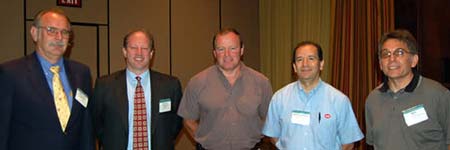



Genetic Markers Allow More Tailored Breeds
US - In the future, genetic markers will make it possible to select for traits previously too difficult or too expensive to measure and incorporate into a breeding programme.Dr Bill Lee of Heritage Breeders made the comment as a panel speaker discussing 'Primary Breeder Trends' at the 2009 Hatchery-Breeder Clinic.
"New genetic testing will allow for breeds to be tailored to individual market niches and customers," he added.
Sponsored by US Poultry & Egg Association's Poultry & Egg Institute, the conference provided a comprehensive look at factors that influence production and performance, such as future breeder trends, effective management practices, and technology advancements at the breeder farm and in the hatchery.
Another breeder panel member, Dr Mike Hellwig of Hubbard, said: "Disease resistance, immune response, and similar traits will depend in part on the progress we make with genetic markers. Other traits suited to markers include livability; egg production, before onset of production; carcass traits, such as yield and fat; and heat tolerance."
Dr Manouchehr Katanbaf of Cobb-Vantress, discussed Cobb's future broiler objectives, which include more meat yield with less feed, better livability and bird welfare, and improved skeletal and cardiovascular health. Cobb's future goals for breeders are more hatching eggs, better hen livability, and maintaining current fertility and hatch.
Dr Derek Emmerson of Aviagen, said that his company will continue their emphasis on broiler traits with better tools for balanced selection. "We're confident that improvements in breeder performance are still possible: for ease of management, persistency, fertility, and hatchability traits. And, new products will expand possibilities," he said.
Mike Czarick, University of Georgia, described the latest research and equipment for energy-saving opportunities at the farm in his presentation 'Reducing pullet/breeder farm energy usage'. Advancements in equipment also play an important role in reducing energy costs in the hatchery, according to Jerry Leyte, Jamesway Incubator.
For example, he said, incubation represents 32 per cenr of energy consumption, and just using variable speed motors can lead to savings. Leyte and Chad Daniels, Chick Master Incubator, discussed valuable energy savings techniques throughout the hatchery.
Jeff Reap, Agri Stats, provided an industry economic outlook. "We should continue to see modest profits in the broiler industry throughout the remainder of 2009 and well into 2010. There could be a shortage of hatching eggs by year's end. There is encouraging crop news, for now. And, freezer inventories should remain low, relative to last year's levels," he said.
However, Mr Reap cautioned that there are important elements that can impact the industry's bottom line, "The wild cards will be whether or not we have any export interruptions and just how much feed prices actually eat into our profit," he added.
The seminar covered time-sensitive topics, including a 'Disease Report', by Dr Joel Cline, Alabama Veterinary Diagnostic Lab, along with a series of other presentations on breeder and hatchery operations, such as 'Back to the Basics for Running an Efficient Hatchery' by Jack Patrick of Harrison Poultry; and 'Brooding Set-Up: Giving Chicks a Good Start' by Dale Simpkins of Perdue Farms.












